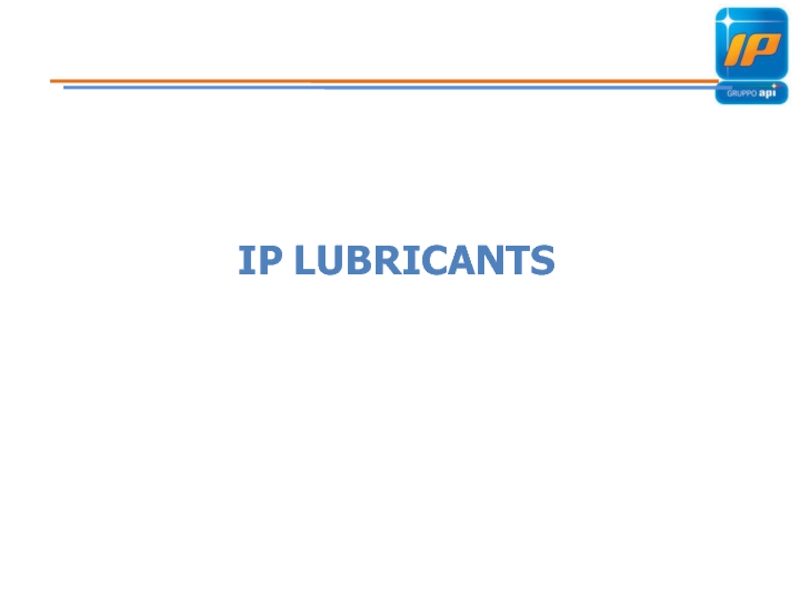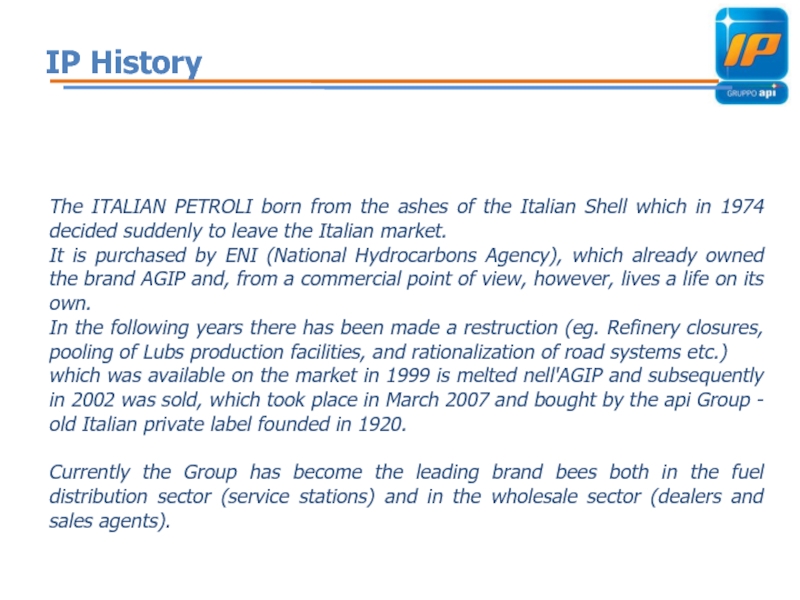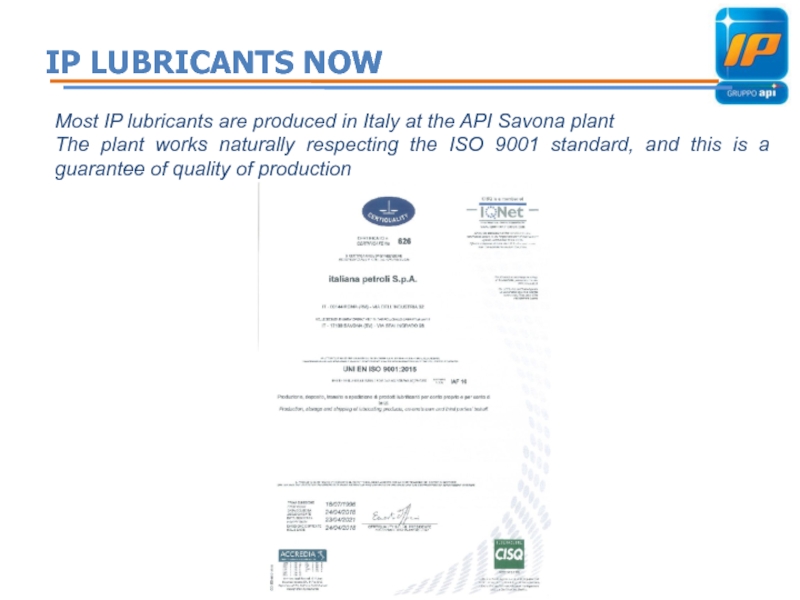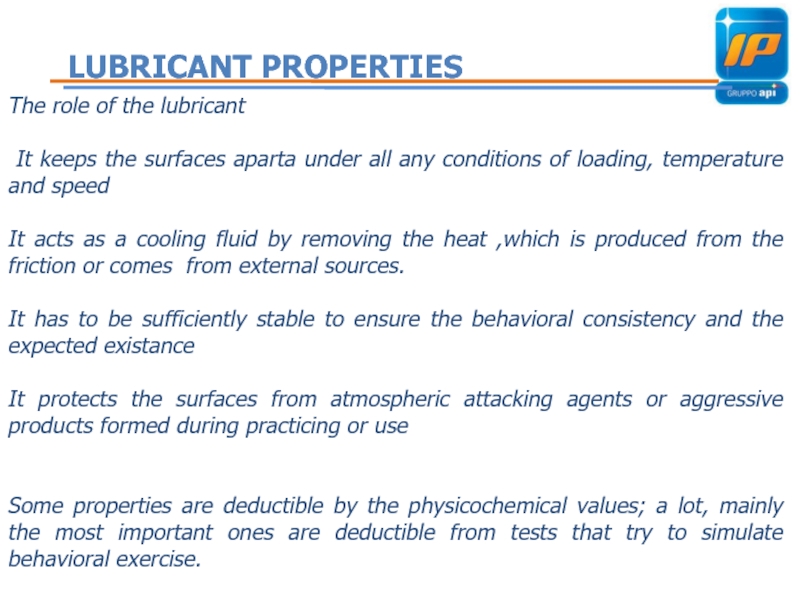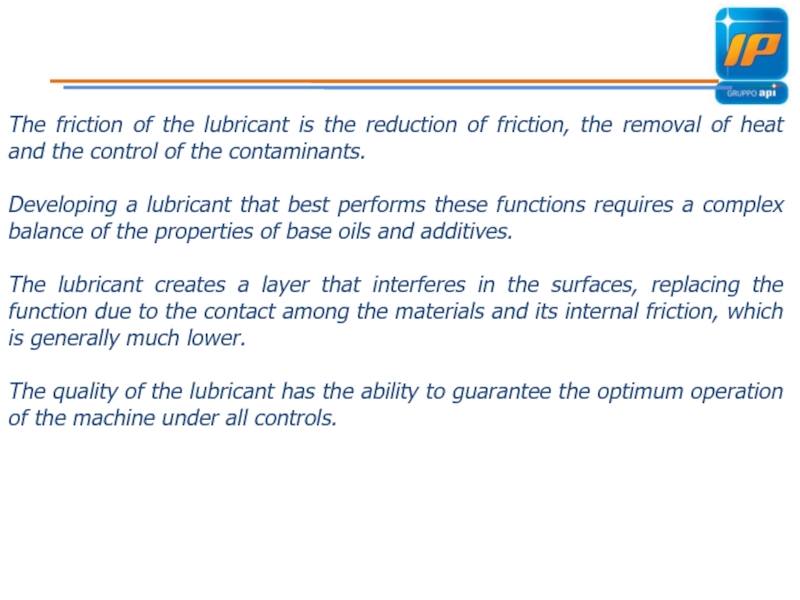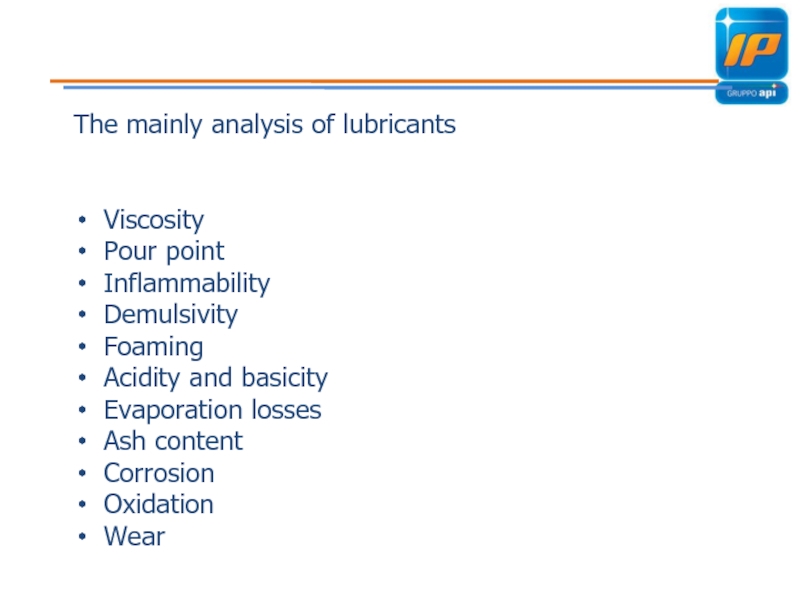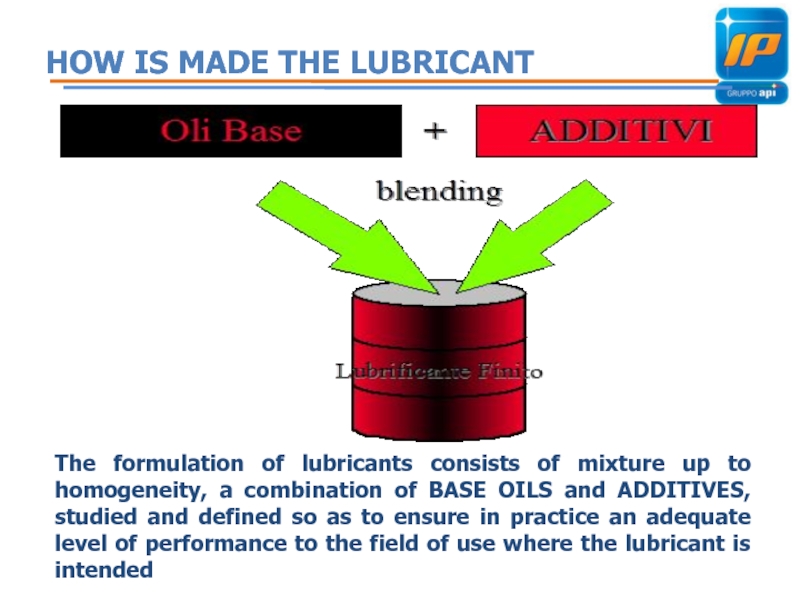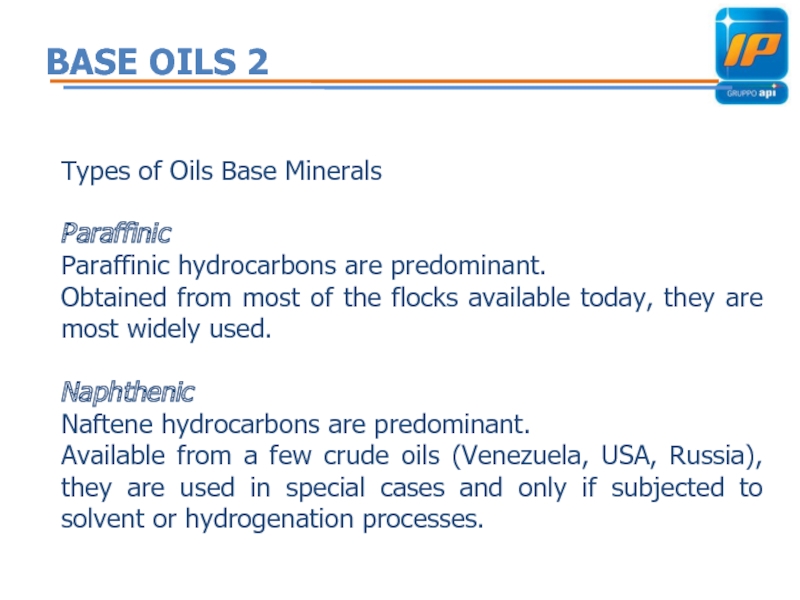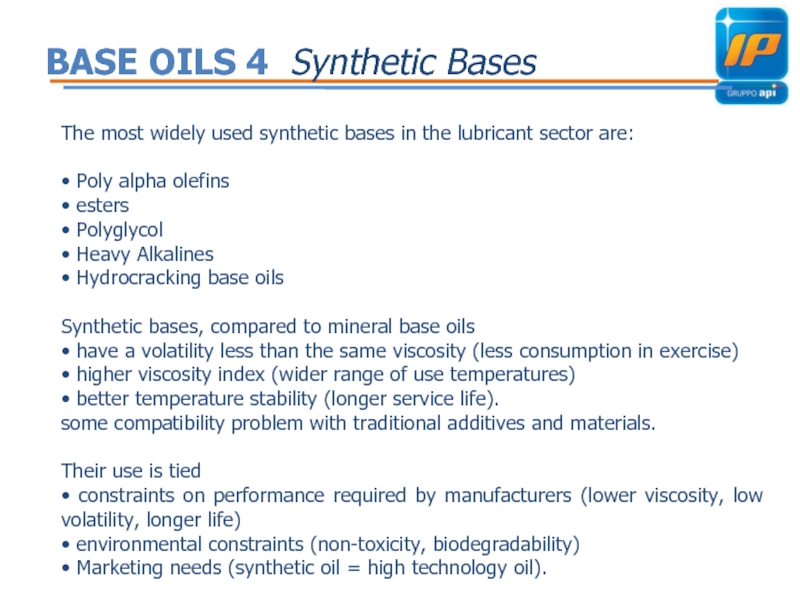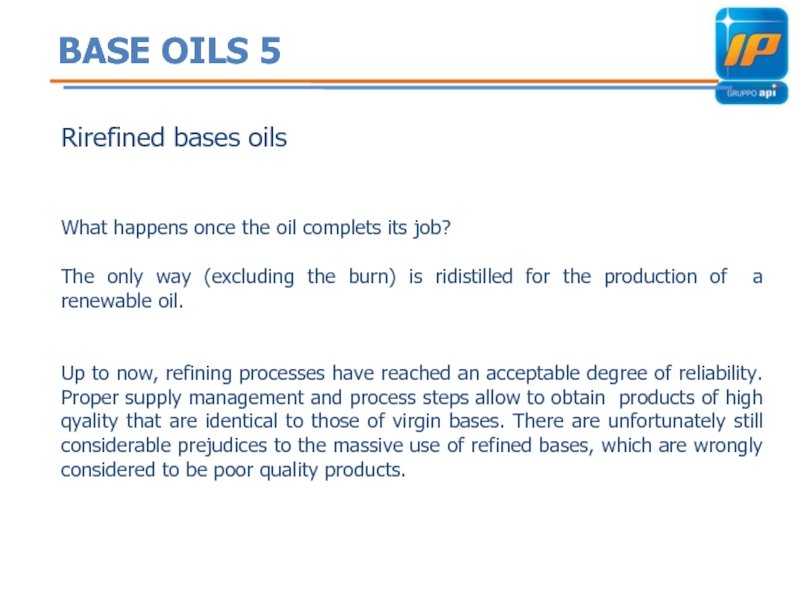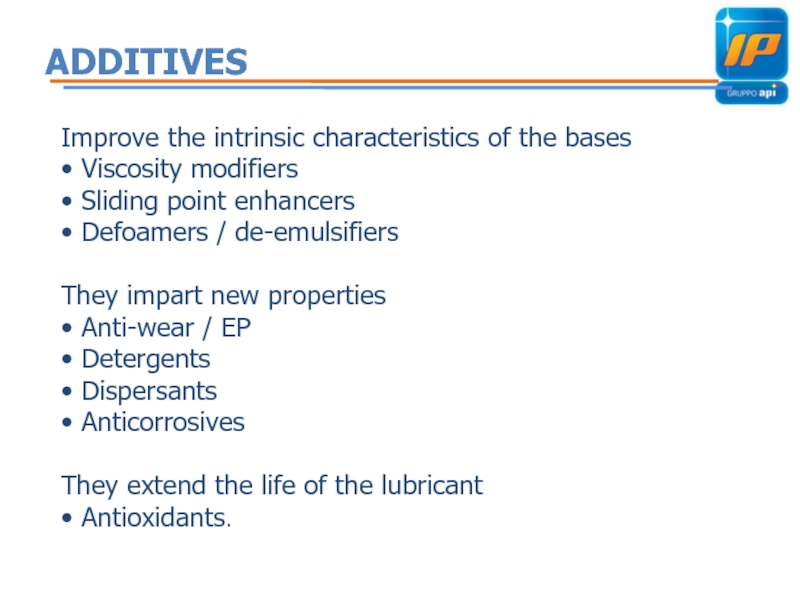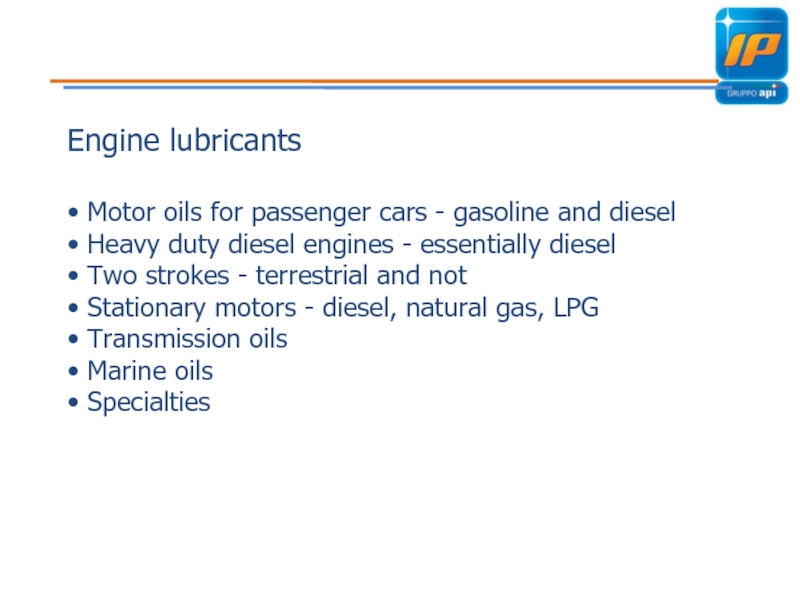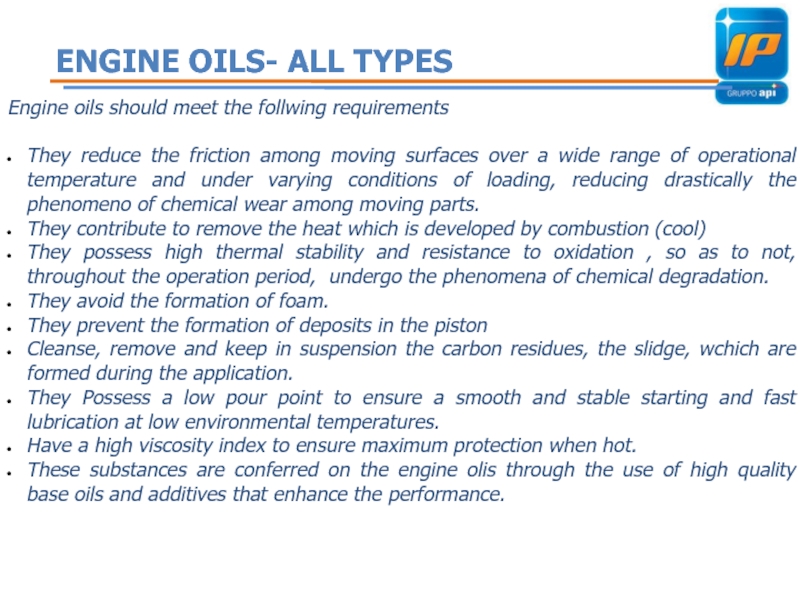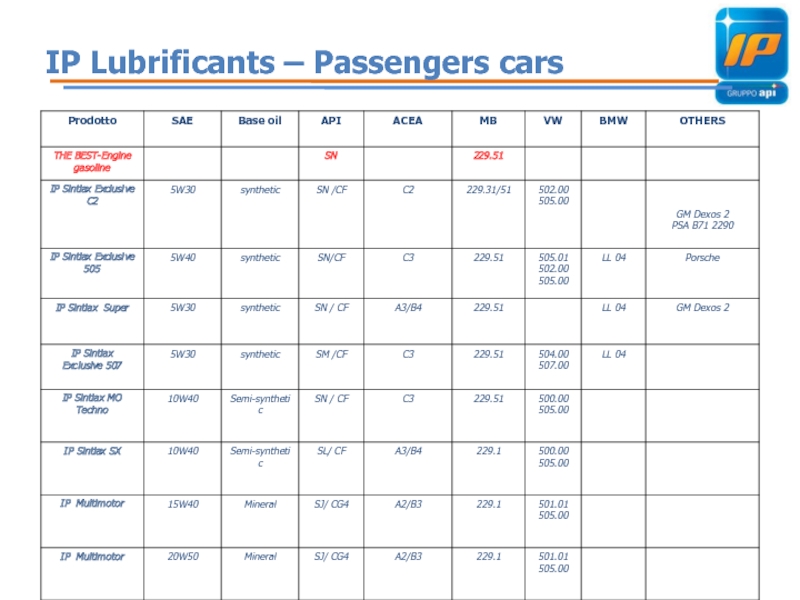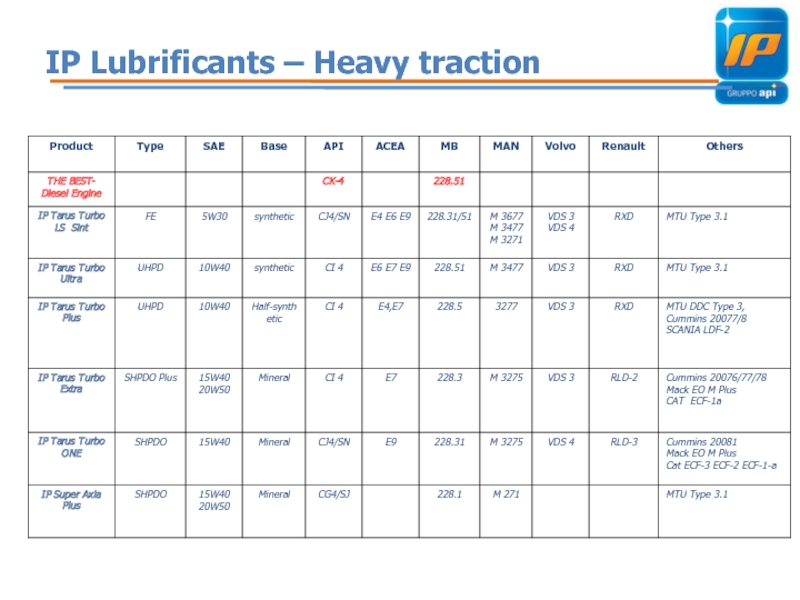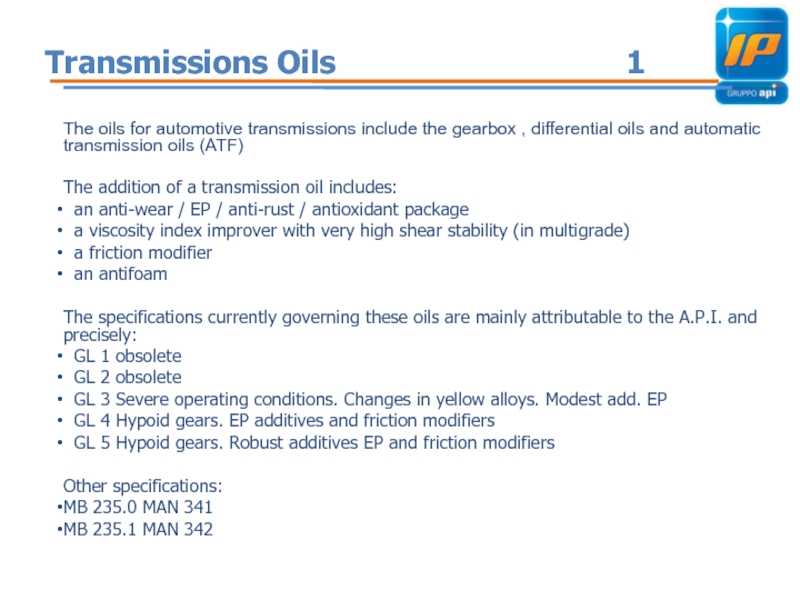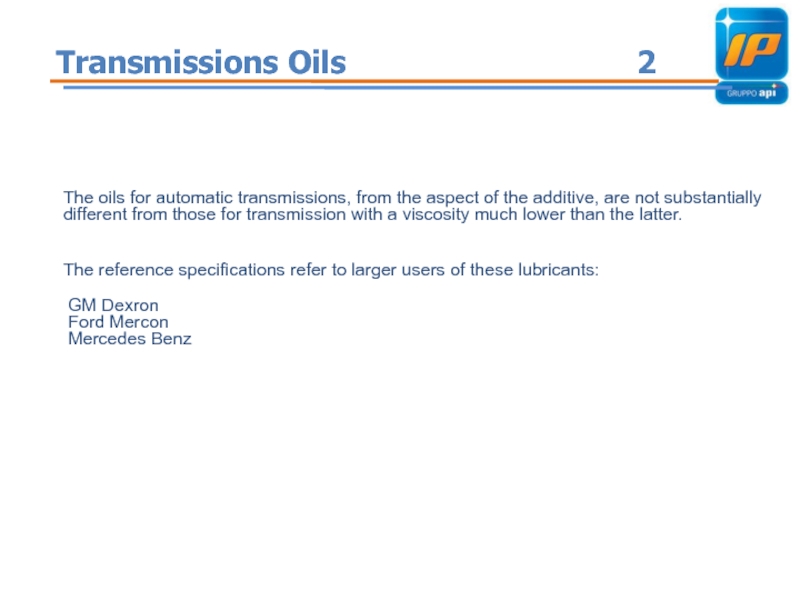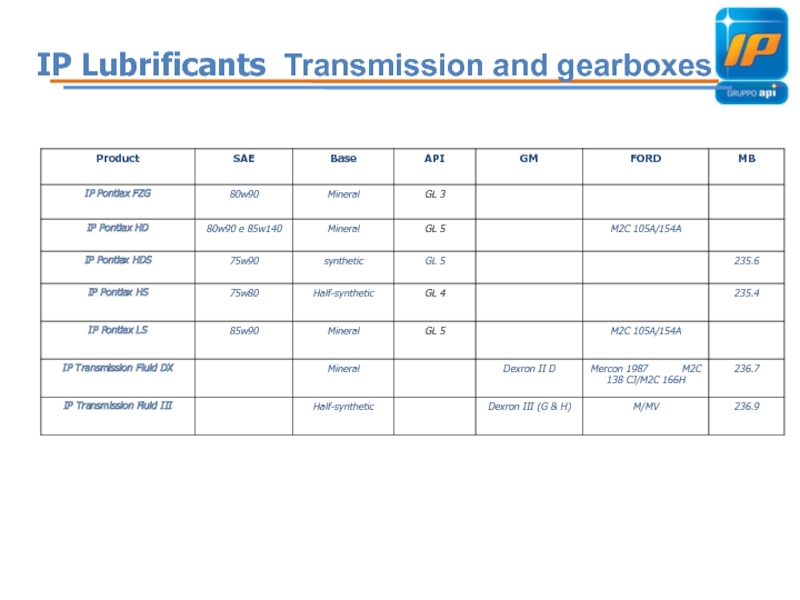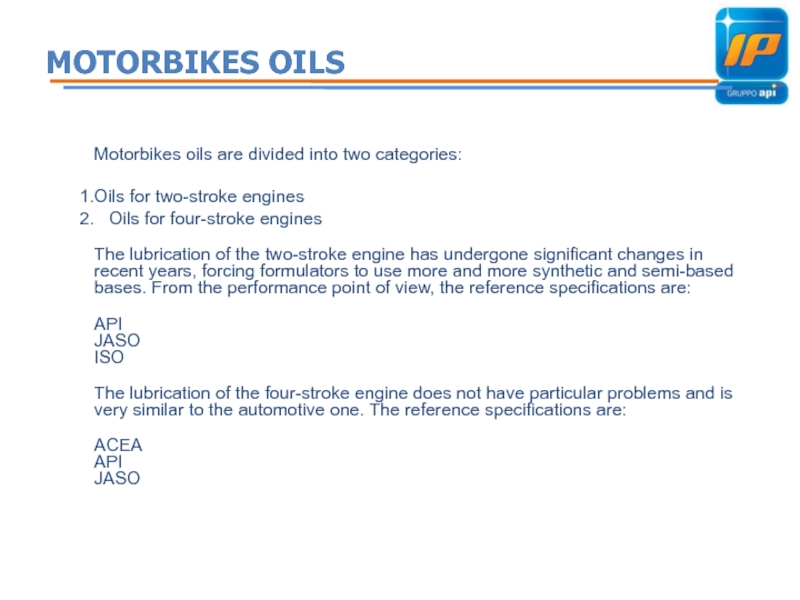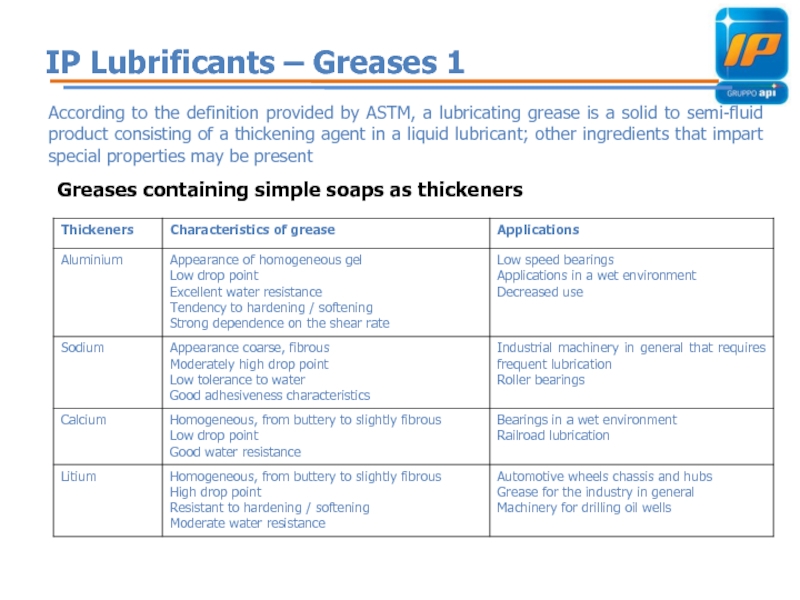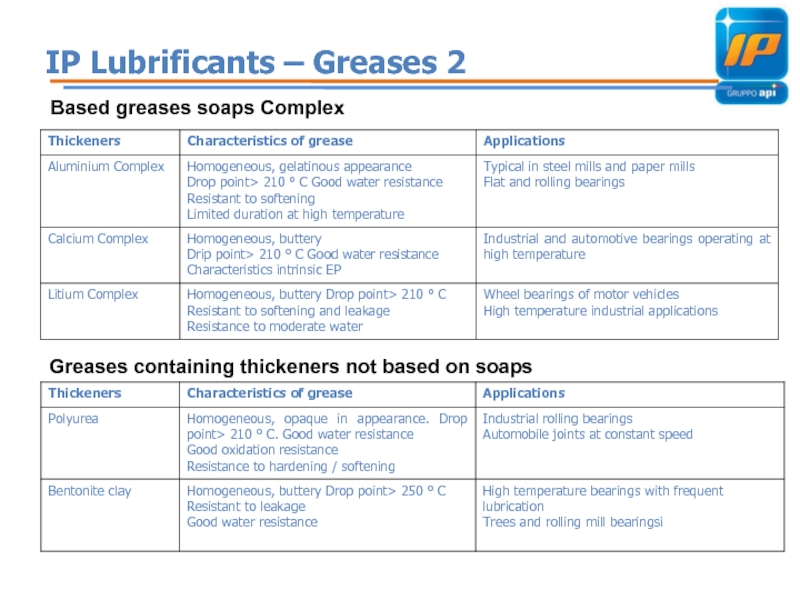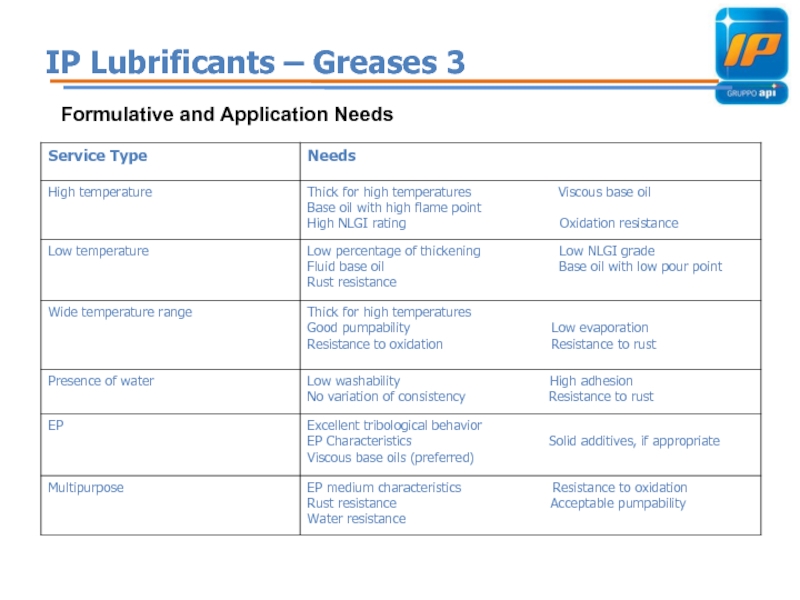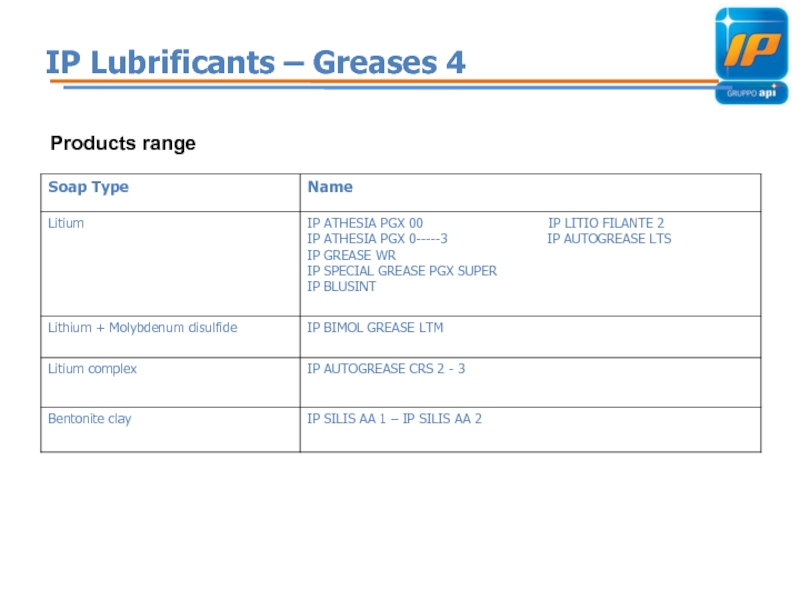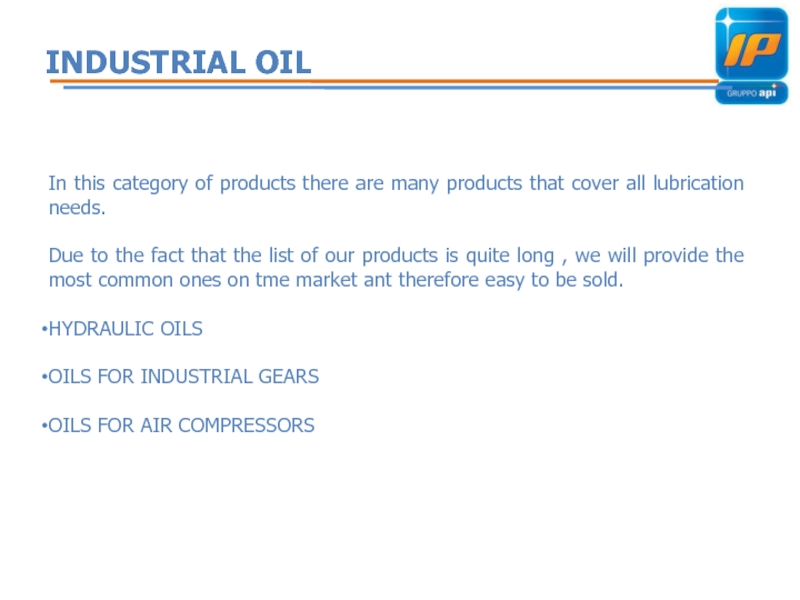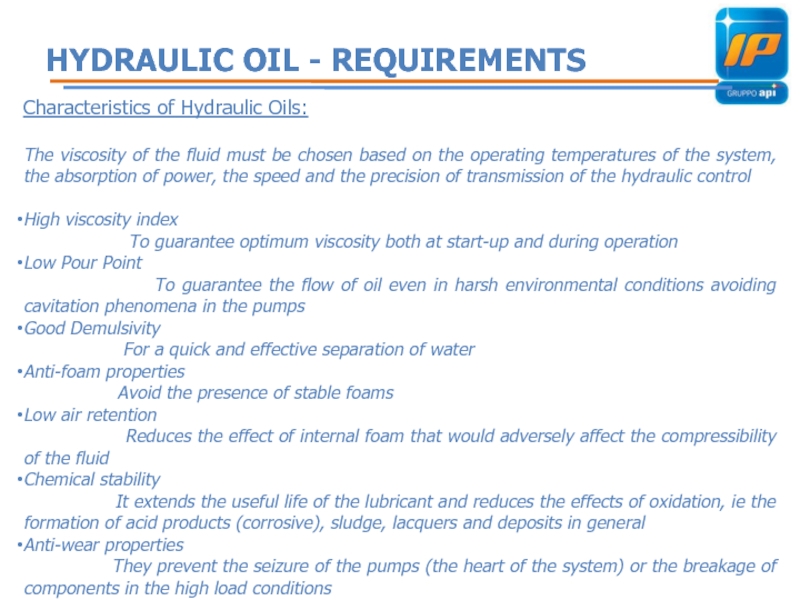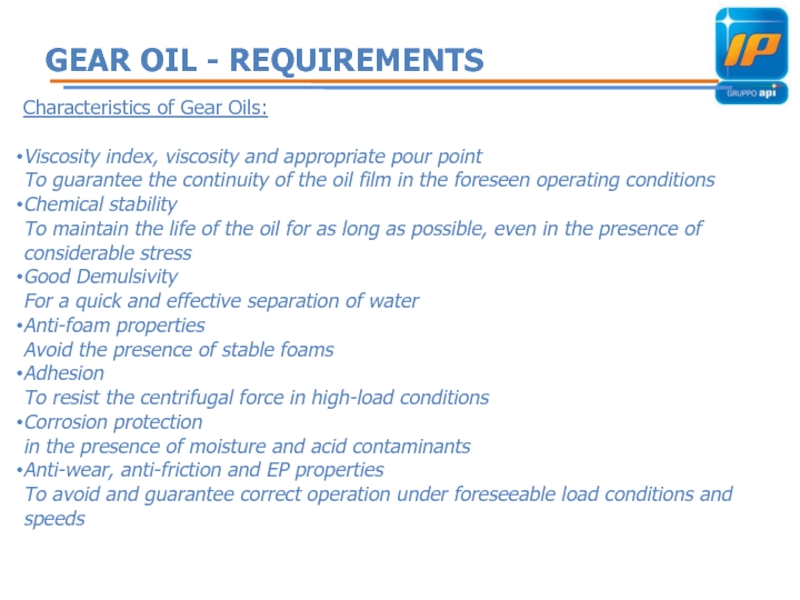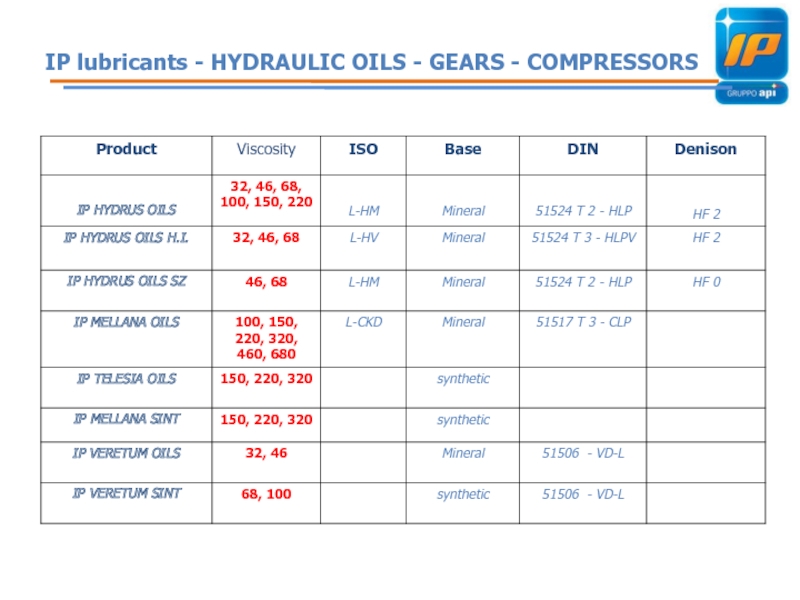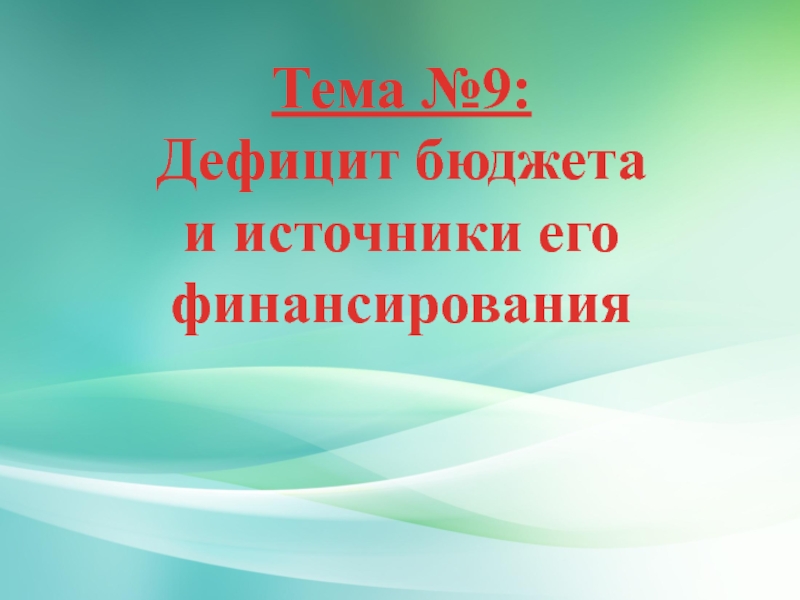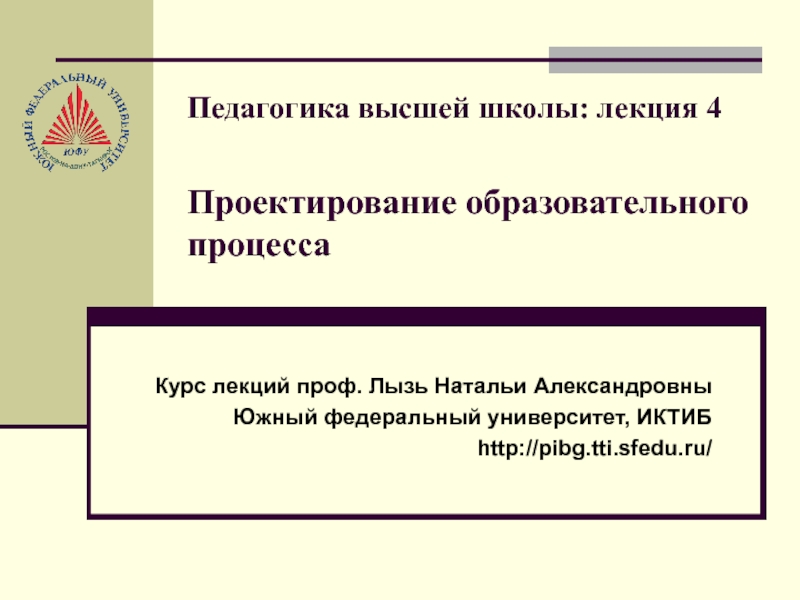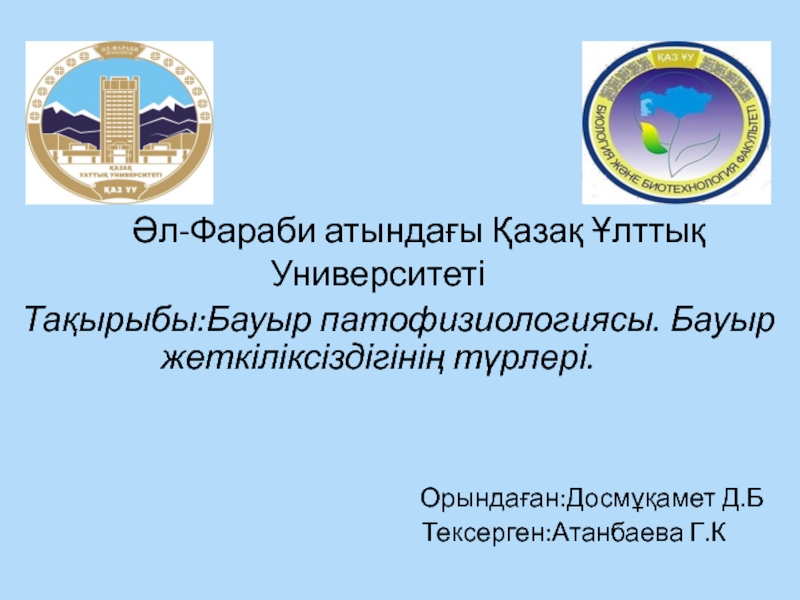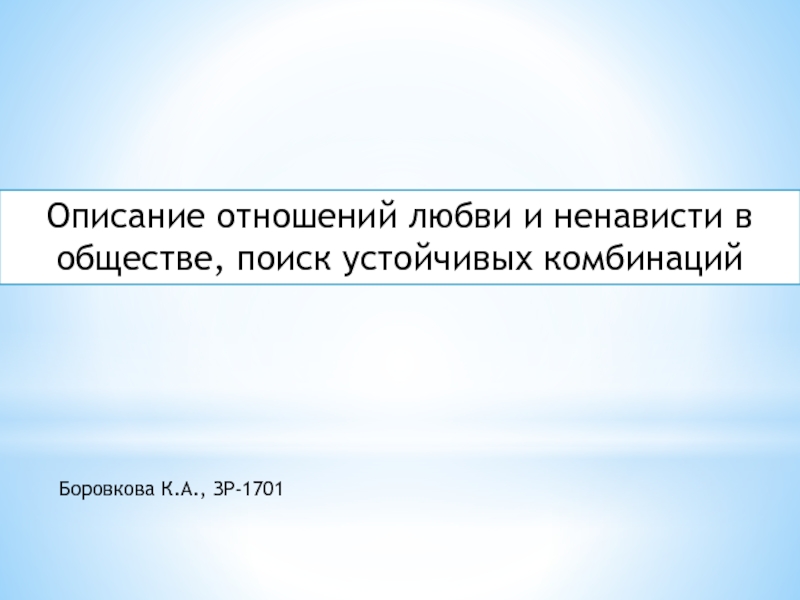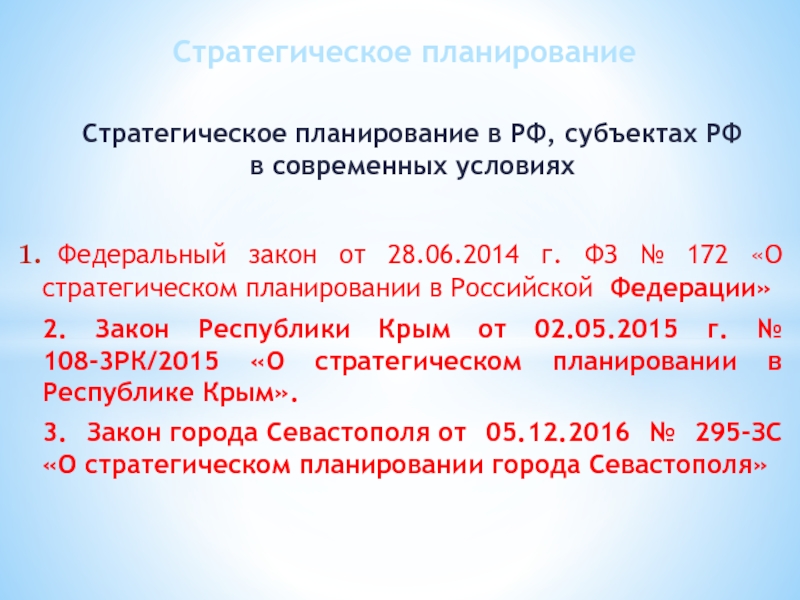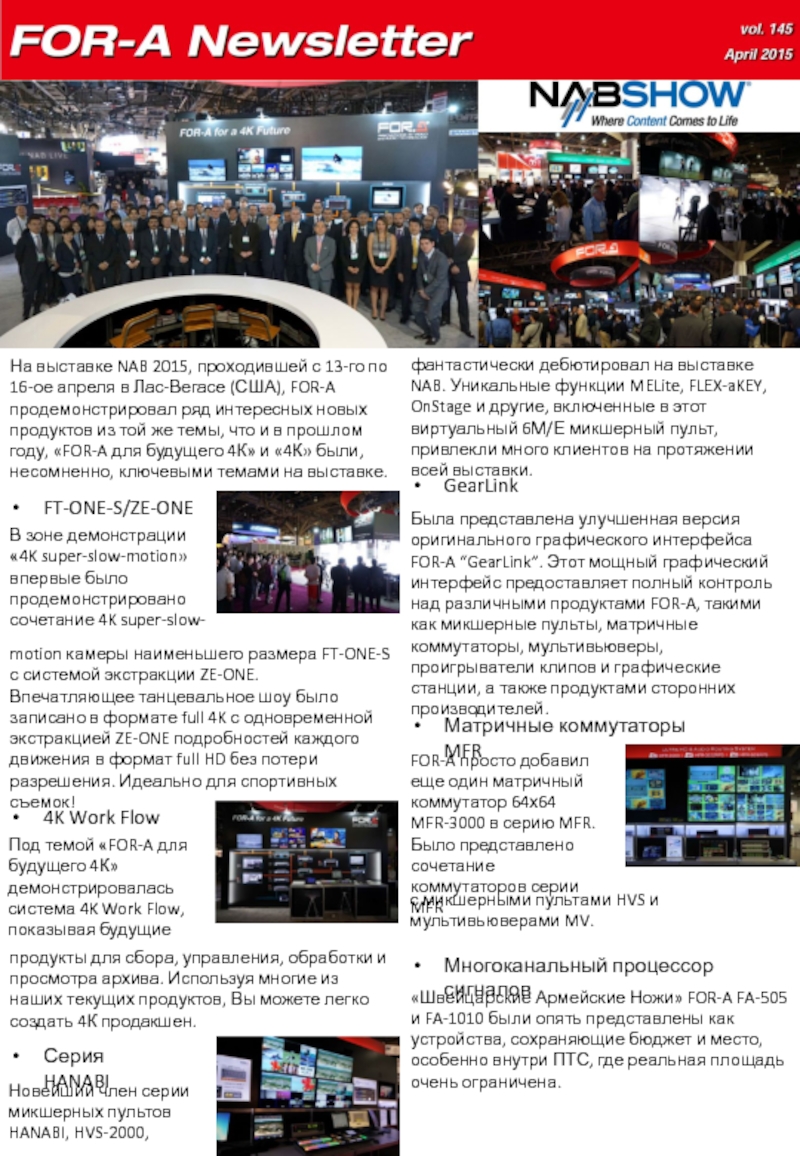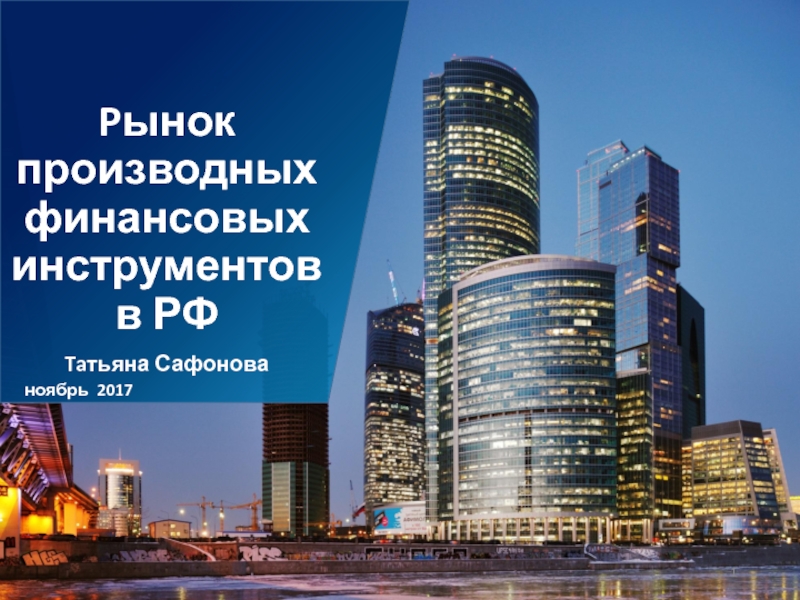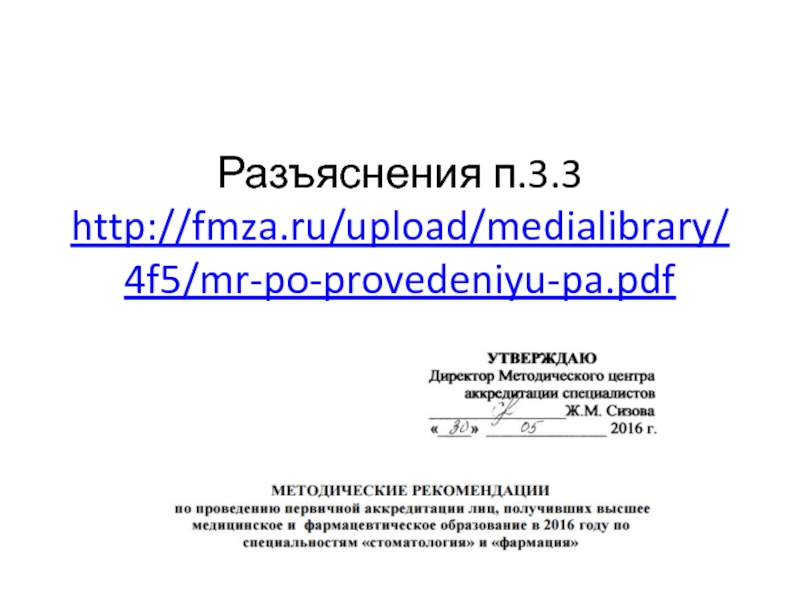Слайд 2IP History
The ITALIAN PETROLI born from the ashes of the
Italian Shell which in 1974 decided suddenly to leave the
Italian market.
It is purchased by ENI (National Hydrocarbons Agency), which already owned the brand AGIP and, from a commercial point of view, however, lives a life on its own.
In the following years there has been made a restruction (eg. Refinery closures, pooling of Lubs production facilities, and rationalization of road systems etc.)
which was available on the market in 1999 is melted nell'AGIP and subsequently in 2002 was sold, which took place in March 2007 and bought by the api Group - old Italian private label founded in 1920.
Currently the Group has become the leading brand bees both in the fuel distribution sector (service stations) and in the wholesale sector (dealers and sales agents).
Слайд 3IP LUBRICANTS NOW
Most IP lubricants are produced in Italy
at the API Savona plant
The plant works naturally respecting the
ISO 9001 standard, and this is a guarantee of quality of production
Слайд 4IP LUBRICANTS NOW
The current formulations are the same not only
for the domestic market but also to foreign countries: that
means, therefore, no recipe difference at all.
They lubricant bases are mainly used by the Italian production sites and only for formulation needs, using base oils from leading foreign manufacturers, especially in the use of synthetic components that are now a fundamental part in the new modern oils.
An important concept: it is not our intention to produce lubricants of IP outside the italian borders. We are an Italian company and, of course, our main market is in Italy; but under these considerations, producing where you live means to have control of the quality of your lubricants.
Слайд 5The role of the lubricant
It keeps the surfaces
aparta under all any conditions of loading, temperature and speed
It
acts as a cooling fluid by removing the heat ,which is produced from the friction or comes from external sources.
It has to be sufficiently stable to ensure the behavioral consistency and the expected existance
It protects the surfaces from atmospheric attacking agents or aggressive products formed during practicing or use
Some properties are deductible by the physicochemical values; a lot, mainly the most important ones are deductible from tests that try to simulate behavioral exercise.
LUBRICANT PROPERTIES
Слайд 6The friction of the lubricant is the reduction of friction,
the removal of heat and the control of the contaminants.
Developing
a lubricant that best performs these functions requires a complex balance of the properties of base oils and additives.
The lubricant creates a layer that interferes in the surfaces, replacing the function due to the contact among the materials and its internal friction, which is generally much lower.
The quality of the lubricant has the ability to guarantee the optimum operation of the machine under all controls.
Слайд 7The mainly analysis of lubricants
Viscosity
Pour point
Inflammability
Demulsivity
Foaming
Acidity and basicity
Evaporation losses
Ash content
Corrosion
Oxidation
Wear
Слайд 8HOW IS MADE THE LUBRICANT
The formulation of lubricants consists of
mixture up to homogeneity, a combination of BASE OILS and
ADDITIVES, studied and defined so as to ensure in practice an adequate level of performance to the field of use where the lubricant is intended
Слайд 9BASE OILS 1
Base oils are still the dominant component in
the vast majority of lubricants.
It is therefore evident that the
final oil depends on the decisive manner of their quality.
Along with mineral bases, obtained from the processing of crude oil, the synthetic bases are increasingly important because they are not present as such in crude oil or because they are not obtained for simple physical-chemical treatment of its fractions.
Слайд 10BASE OILS 2
Types of Oils Base Minerals
Paraffinic
Paraffinic hydrocarbons are predominant.
Obtained
from most of the flocks available today, they are most
widely used.
Naphthenic
Naftene hydrocarbons are predominant.
Available from a few crude oils (Venezuela, USA, Russia), they are used in special cases and only if subjected to solvent or hydrogenation processes.
Слайд 11BASE OILS 3
Classification of Base Oils
The different fractions, or cuts,
of base oils produced are classified internationally based on SUS
(Sayboldt Universal Seconds) viscosity measured at 40 or 100 ° C (100 or 210 ° F)
The number indicating the SUS viscosity is preceded by a type SN (Solvent Neutral) or HVI (High Viscosity Index) which indicates the production process used. The BS mark is used for the heaviest cutable (Bright Stock)
The number of cuts and their viscosimetric characteristics depend on the manufacturer and the type of process
Normally they are produced:
- a very fluid cut (SN 80 ÷ 100 or spindle)
- a fluid cut (SN 125 ÷ 170 typically 150)
- an average cut (SN 350 ÷ 600)
- a Bright Stock (BS 150 or 200)
Слайд 12BASE OILS 4 Synthetic Bases
The most widely used synthetic bases
in the lubricant sector are:
• Poly alpha olefins
• esters
• Polyglycol
•
Heavy Alkalines
• Hydrocracking base oils
Synthetic bases, compared to mineral base oils
• have a volatility less than the same viscosity (less consumption in exercise)
• higher viscosity index (wider range of use temperatures)
• better temperature stability (longer service life).
some compatibility problem with traditional additives and materials.
Their use is tied
• constraints on performance required by manufacturers (lower viscosity, low volatility, longer life)
• environmental constraints (non-toxicity, biodegradability)
• Marketing needs (synthetic oil = high technology oil).
Слайд 13BASE OILS 5
Rirefined bases oils
What happens once the oil complets
its job?
The only way (excluding the burn) is ridistilled for
the production of a renewable oil.
Up to now, refining processes have reached an acceptable degree of reliability. Proper supply management and process steps allow to obtain products of high qyality that are identical to those of virgin bases. There are unfortunately still considerable prejudices to the massive use of refined bases, which are wrongly considered to be poor quality products.
Слайд 14ADDITIVES
Improve the intrinsic characteristics of the bases
• Viscosity modifiers
• Sliding
point enhancers
• Defoamers / de-emulsifiers
They impart new properties
• Anti-wear /
EP
• Detergents
• Dispersants
• Anticorrosives
They extend the life of the lubricant
• Antioxidants.
Слайд 15Engine lubricants
• Motor oils for passenger cars - gasoline and
diesel
• Heavy duty diesel engines - essentially diesel
• Two strokes
- terrestrial and not
• Stationary motors - diesel, natural gas, LPG
• Transmission oils
• Marine oils
• Specialties
Слайд 16Engine oils should meet the follwing requirements
They reduce the friction
among moving surfaces over a wide range of operational temperature
and under varying conditions of loading, reducing drastically the phenomeno of chemical wear among moving parts.
They contribute to remove the heat which is developed by combustion (cool)
They possess high thermal stability and resistance to oxidation , so as to not, throughout the operation period, undergo the phenomena of chemical degradation.
They avoid the formation of foam.
They prevent the formation of deposits in the piston
Cleanse, remove and keep in suspension the carbon residues, the slidge, wchich are formed during the application.
They Possess a low pour point to ensure a smooth and stable starting and fast lubrication at low environmental temperatures.
Have a high viscosity index to ensure maximum protection when hot.
These substances are conferred on the engine olis through the use of high quality base oils and additives that enhance the performance.
ENGINE OILS- ALL TYPES
Слайд 17IP Lubrificants – Passengers cars
Слайд 18IP Lubrificants – Heavy traction
Слайд 19Transmissions Oils
1
The oils for
automotive transmissions include the gearbox , differential oils and automatic transmission oils (ATF)
The addition of a transmission oil includes:
an anti-wear / EP / anti-rust / antioxidant package
a viscosity index improver with very high shear stability (in multigrade)
a friction modifier
an antifoam
The specifications currently governing these oils are mainly attributable to the A.P.I. and precisely:
GL 1 obsolete
GL 2 obsolete
GL 3 Severe operating conditions. Changes in yellow alloys. Modest add. EP
GL 4 Hypoid gears. EP additives and friction modifiers
GL 5 Hypoid gears. Robust additives EP and friction modifiers
Other specifications:
MB 235.0 MAN 341
MB 235.1 MAN 342
Слайд 20Transmissions Oils
2
The oils for
automatic transmissions, from the aspect of the additive, are not substantially different from those for transmission with a viscosity much lower than the latter.
The reference specifications refer to larger users of these lubricants:
GM Dexron
Ford Mercon
Mercedes Benz
Слайд 21IP Lubrificants Transmission and gearboxes
Слайд 22MOTORBIKES OILS
Motorbikes oils are divided into two categories:
Oils for two-stroke
engines
Oils for four-stroke engines
The lubrication of the two-stroke
engine has undergone significant changes in recent years, forcing formulators to use more and more synthetic and semi-based bases. From the performance point of view, the reference specifications are:
API
JASO
ISO
The lubrication of the four-stroke engine does not have particular problems and is very similar to the automotive one. The reference specifications are:
ACEA
API
JASO
Слайд 23IP Lubrificants – MOTORBIKES OILS
Слайд 24IP Lubrificants – Greases 1
According to the definition provided by
ASTM, a lubricating grease is a solid to semi-fluid product
consisting of a thickening agent in a liquid lubricant; other ingredients that impart special properties may be present
Greases containing simple soaps as thickeners
Слайд 25IP Lubrificants – Greases 2
Based greases soaps Complex
Greases containing thickeners
not based on soaps
Слайд 26IP Lubrificants – Greases 3
Formulative and Application Needs
Слайд 27IP Lubrificants – Greases 4
Products range
Слайд 28INDUSTRIAL OIL
In this category of products there are many products
that cover all lubrication needs.
Due to the fact that the
list of our products is quite long , we will provide the most common ones on tme market ant therefore easy to be sold.
HYDRAULIC OILS
OILS FOR INDUSTRIAL GEARS
OILS FOR AIR COMPRESSORS
Слайд 29HYDRAULIC OIL - REQUIREMENTS
Characteristics of Hydraulic Oils:
The viscosity of the
fluid must be chosen based on the operating temperatures of
the system, the absorption of power, the speed and the precision of transmission of the hydraulic control
High viscosity index
To guarantee optimum viscosity both at start-up and during operation
Low Pour Point
To guarantee the flow of oil even in harsh environmental conditions avoiding cavitation phenomena in the pumps
Good Demulsivity
For a quick and effective separation of water
Anti-foam properties
Avoid the presence of stable foams
Low air retention
Reduces the effect of internal foam that would adversely affect the compressibility of the fluid
Chemical stability
It extends the useful life of the lubricant and reduces the effects of oxidation, ie the formation of acid products (corrosive), sludge, lacquers and deposits in general
Anti-wear properties
They prevent the seizure of the pumps (the heart of the system) or the breakage of components in the high load conditions
Слайд 30GEAR OIL - REQUIREMENTS
Characteristics of Gear Oils:
Viscosity index, viscosity and
appropriate pour point
To guarantee the continuity of the oil film
in the foreseen operating conditions
Chemical stability
To maintain the life of the oil for as long as possible, even in the presence of considerable stress
Good Demulsivity
For a quick and effective separation of water
Anti-foam properties
Avoid the presence of stable foams
Adhesion
To resist the centrifugal force in high-load conditions
Corrosion protection
in the presence of moisture and acid contaminants
Anti-wear, anti-friction and EP properties
To avoid and guarantee correct operation under foreseeable load conditions and speeds
Слайд 31AIR COMPRESSORS OIL - REQUIREMENTS
Characteristics of oils for air compressors:
Viscosity
index, viscosity
To guarantee the continuity of the oil film in
the foreseen operating conditions
Oxidative stability
To maintain the life of the oil for as long as possible, even in the presence of considerable stress
Good Demulsivity
For a quick and effective separation of water
Anti-foam properties
Avoid the presence of stable foams
Corrosion protection
in the presence of moisture and acid contaminants
Anti-wear properties
To avoid and guarantee correct operation under foreseeable load conditions and speeds
Слайд 32IP lubricants - HYDRAULIC OILS - GEARS - COMPRESSORS
